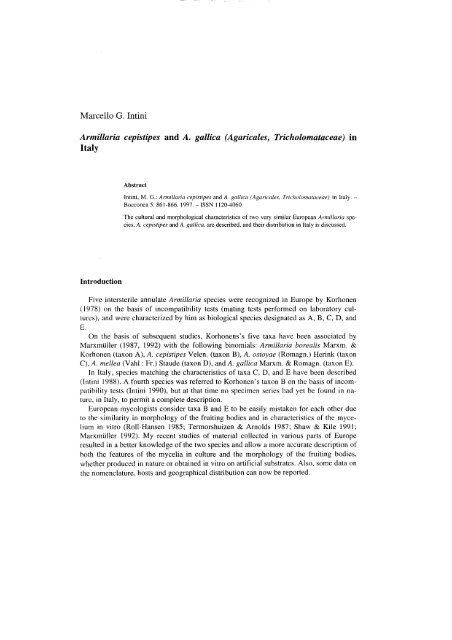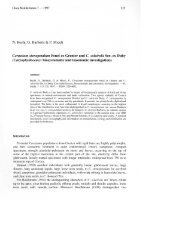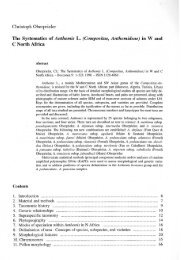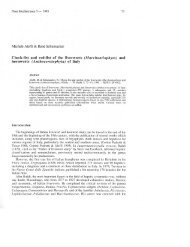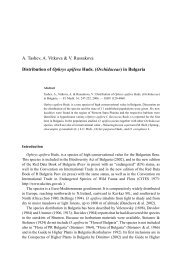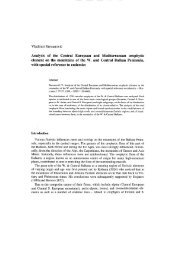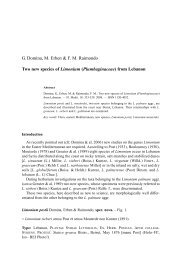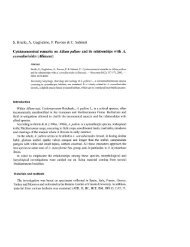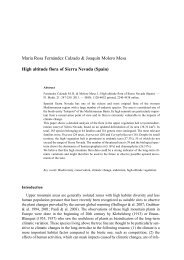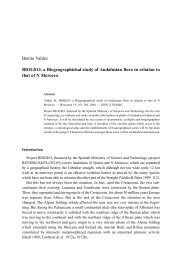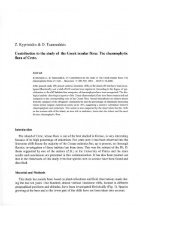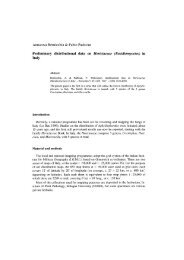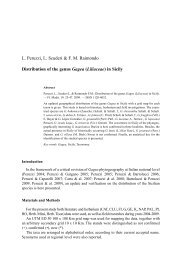Armillaria cepistipes and A. gallica (Agaricales ... - Herbmedit.org
Armillaria cepistipes and A. gallica (Agaricales ... - Herbmedit.org
Armillaria cepistipes and A. gallica (Agaricales ... - Herbmedit.org
You also want an ePaper? Increase the reach of your titles
YUMPU automatically turns print PDFs into web optimized ePapers that Google loves.
Marcello G. Intini<br />
<strong>Armillaria</strong> <strong>cepistipes</strong> <strong>and</strong> A. <strong>gallica</strong> (<strong>Agaricales</strong>, Tricholomataceae) in<br />
Italy<br />
Introduction<br />
Abstract<br />
[ntini, M. G.: <strong>Armillaria</strong> <strong>cepistipes</strong> <strong>and</strong> A. <strong>gallica</strong> (<strong>Agaricales</strong>, Tricholomataceae) in Italy. -<br />
Bocconea 5: 861-866. 1997. - ISSN 1120-4060.<br />
The cultural <strong>and</strong> morphological characteristics of two very similar European <strong>Armillaria</strong> species,<br />
A. <strong>cepistipes</strong> <strong>and</strong> A. <strong>gallica</strong>, are described, <strong>and</strong> their distribution in Italy is discussed.<br />
Five intersterile annuIate <strong>Armillaria</strong> species were recognized in Europe by Korhonen<br />
(1978) on the basis of incompatibility tests (mating tests performed on laboratory cultures),<br />
<strong>and</strong> were characterized by him as biological species designated as A, B, C, D, <strong>and</strong><br />
E.<br />
On the basis of subsequent studies, Korhonens's five taxa have been associated by<br />
Marxmi.iller (1987, 1992) with the following binomials: <strong>Armillaria</strong> borealis Marxm. &<br />
Korhonen (taxon A), A. <strong>cepistipes</strong> Velen. (taxon B), A. ostoyae (Romagn.) Herink (taxon<br />
C), A. mellea (Vahl : Fr.) Staude (taxon D), <strong>and</strong> A. <strong>gallica</strong> Marxm. & Romagn. (taxon E).<br />
In Italy, species matching the characteristics of taxa C, D, <strong>and</strong> E have been described<br />
(Intini 1988). A fourth species was referred to Korhonen's taxon B on the basis of incompatibility<br />
tests (Intini 1990), but at that ti me no specimen series had yet be found in nature,<br />
in Italy, to permit a complete description.<br />
European mycologists consider taxa B<strong>and</strong> E to be easily mistaken for each other due<br />
to the similarity in morphology of the fruiting bodies <strong>and</strong> in characteristics of the mycelium<br />
in vitro (Roll-Hansen 1985; Termorshuizen & Arnolds 1987; Shaw & Kile 1991;<br />
Marxmi.iller 1992). My recent studies of material collected in various parts of Europe<br />
resulted in a better knowledge of the two species <strong>and</strong> allow a more accurate description of<br />
both the features of the mycelia in culture <strong>and</strong> the morphology of the fruiting bodies,<br />
whether produced in nature or obtained in vitro on artificial substrates. AIso, some data on<br />
the nomenc1ature, hosts <strong>and</strong> geographical distribution can now be reported.
862 Intini: <strong>Armillaria</strong> in ltaly<br />
Material <strong>and</strong> methods<br />
In the peri od 1990-1992, over one thous<strong>and</strong> samples of fruiting bodies <strong>and</strong> cultures of<br />
<strong>Armillaria</strong> <strong>cepistipes</strong> (taxon B) <strong>and</strong> A. <strong>gallica</strong> (taxon E), from numerous ltalian sites <strong>and</strong><br />
from across the Alps, were examined. Special attention was paid to the observation of<br />
A<br />
B<br />
Fig. l. Fruiting bodies of <strong>Armillaria</strong> <strong>cepistipes</strong> (A) <strong>and</strong> A. <strong>gallica</strong> (B l.
Bocconea 5(2) - 1997 863<br />
Fig. 2. <strong>Armillaria</strong>. - A-B, young fruiting bodies of A. <strong>cepistipes</strong> found in nature (A) <strong>and</strong> differentiated<br />
in vitro (B). - C-D, young fruiting bodies of A. <strong>gallica</strong> found in nature (C) <strong>and</strong> differentiated<br />
in vitro (D). - E-F, rhizomorphs of A. <strong>cepistipes</strong> in vitro (E) <strong>and</strong> A. <strong>gallica</strong> (F), both in vitro.<br />
B<br />
D<br />
F
864 Intini: <strong>Armillaria</strong> in Italy<br />
the ontogeny of the fruiting bodies, starting from their earliest stages of growth. All descriptions<br />
were made on the basis of fresh specimens that had developed under normal<br />
conditions.<br />
Mycelia of the two species that had been produced in culture, designated with the initials<br />
AB-PT <strong>and</strong> IN-MA, respectively, were sent to institutes at Clermont-Ferr<strong>and</strong> <strong>and</strong><br />
Zurich where their identity was confirmed by means of incompatibility trials with testers.<br />
Results<br />
<strong>Armillaria</strong> <strong>cepistipes</strong> (Fig. lA, 2A-B, E).<br />
Macroscopic characters. - Pileus initially pale grey then light brown, up to 150 mm<br />
across, initially conical then flattened, covered with small dark squamules. Lamellae<br />
decurrent or subdecurrent, initially white then cream-coloured. Stalk up to 120 mm long<br />
<strong>and</strong> 35 mm thick, cylindrical but slight1y thickened at the base, with no dark squamules<br />
but covered with sparse tufts of nearly white mycelium. Ring cortiniform, nearly white.<br />
Morphology oj jruiting bodies differentiated in vitro. - Colour initially ash-coloured.<br />
Surface of the pileus covered with fine hairs of a darker colour, light brown <strong>and</strong> with<br />
darker brown scales when exp<strong>and</strong>ed. Stipe thickened at the base, ring cortiniform <strong>and</strong><br />
white.<br />
Microscopic characters. - Basidiospores smooth, elongated, drop-shaped, 6.2-9.6 x<br />
4.2-6.3 J..lm. Basidia 4-sterigmate, claviform, 25-40 x 5.5-8.5 J..lm, with clamp connections<br />
at the base. Cheilocystidia utriform or claviform, 15-40 x 8.5 J..lm. Squamules on the<br />
pileus 0.5-1.5 mm long, formed by cylindrical to fusiform multiseptate hyphae, hyphal<br />
cells 10-70 x 5-25 J..lm.<br />
Characteristics oj rhizomorphs cultured in Petri dishes. - Rhizomorphs circular in<br />
cross-section, with scarce branching. Agar around the rhizomorphs with considerable<br />
pigmentation.<br />
Habitat. - <strong>Armillaria</strong> <strong>cepistipes</strong> is an mol.mtain species that has been found at altitudes<br />
ranging from 600 to 1500 m, often in association with A. ostoyae. It grows in conifer <strong>and</strong><br />
broadleaf woods in the montane <strong>and</strong> submontane zone of the Alps as well as in conifer<br />
<strong>and</strong> broadleaf plantations in the Apennines (from Liguria east to Tuscany-Emilia <strong>and</strong><br />
south-east to Calabria). It has not yet been recorded from Sicily or Sardinia. In the mountains<br />
of Italy, it is the first species of the genus to set fruit; when it grows together with A.<br />
ostoyae, the latter appears one or two weeks later.<br />
<strong>Armillaria</strong> <strong>gallica</strong> (Fig. lB, 2C-D, F).<br />
Macroscopic characters. - Pileus initially greenish-yellow then ochre or burnt sienna, up<br />
to 160 mm across, at first obtusely conical then flattened, at times appressed, covered with<br />
darker squamules that may be weathered off in nature in adult specimens, in which case<br />
the pileus surface becomes brownish-yellowish <strong>and</strong> translucent. Lamellae wide, decurrent,<br />
initially white then creamy rusty-brown. Stalk up to 150 mm long <strong>and</strong> 40 mm thick,
Bocconea 5(2) - 1997 865<br />
cylindrical but thickened at the base <strong>and</strong> covered with yellow flocci. Ring pale yellow,<br />
wide <strong>and</strong> turned upwards, appearing shredded into a star shape.<br />
Morphology oj jruiting bodies produced in vitro. - Colour initially yellow, fading to<br />
light yellow in the adult stage. Surface of the pileus covered with fine hairs, with various<br />
shades of brown, but covered by shades of dark brown squamules. Stipe nearly cylindrical<br />
but thickened at the base, with a more or less pronounced ring.<br />
Microscopic characters. - Basidiospores smooth, almond-shaped or elongated <strong>and</strong><br />
drop-shaped, 7-10 x 4.5-6.5 11m. Basidia 4-sterigmate, claviform, 30-45 x 6-9 11m, with<br />
rare clamp connections at the base. Cheilocystidia utriform or claviform, 15-30(-50) x 5-<br />
7(-10) 11m. Squamules on the pileus 1-2.5 mm long, formed by cylindrical to fusiform<br />
multiseptate hyphae, hyphal cells 25-120 x 10-35 11m.<br />
Characteristics oj rhizomorphs cultured in Petri dishes. - Rhizomorphs circular in<br />
cross-section, with comb-like branches. Agar around the rhizomorphs with slight pigmentation.<br />
Habitat. - <strong>Armillaria</strong> <strong>gallica</strong> is widespread both in the Mediterranean macchia, where<br />
it is mostIy associated with Quercus species, <strong>and</strong> in forests of Fagus at altitudes ranging<br />
from 600 to 1500 metres. It has been found in various piaces in northern, centraI <strong>and</strong><br />
southern Italy as well as on the large isl<strong>and</strong>s.<br />
Nomenclatural remarks<br />
Korhonen's taxon B has been equated by Marxmiiller with <strong>Armillaria</strong> <strong>cepistipes</strong>. However,<br />
Velenovskfs hoIotype (PRC) is an aberrant form that deviates strongIy from the<br />
great majority of specimens presentIy assigned to this species, which rather resembie<br />
thosc of <strong>Armillaria</strong> <strong>gallica</strong> (Marxmiiller, 1987; 1992).<br />
In view of this discrepancy, it may prove necessary to rcdescribe <strong>and</strong> rename taxon B<br />
as a new species, if possible by consensus among those working on the genus <strong>Armillaria</strong>.<br />
One might then choose an epithet that accounts better for the salient characteristics of this<br />
particular species. To our mind, the epithet <strong>cepistipes</strong> (from Latin cepa = onion <strong>and</strong> stipes<br />
= stalk, meaning "with a buIbous stalk") is ili suited for use restricted to any particular<br />
<strong>Armillaria</strong> species, since they ali present, at least at some stage of their ontogenesis, a<br />
staIk that is thickened at the base.<br />
Korhonen' s taxon E has been described <strong>and</strong> named by Marxmiiller (1987; 1992) as a<br />
new species, <strong>Armillaria</strong> <strong>gallica</strong>, a name that we have retained for the time being. On the<br />
basis of our own investigations, however, the name <strong>Armillaria</strong> lutea Gillet (1874), judging<br />
from its protologue, beIongs to the same species <strong>and</strong>, if indeed synonymous, has priority.<br />
The epithet lutea (yellow) wouId, we think, be well suited to denote this <strong>Armillaria</strong><br />
spccies, since yellow is the prevailing colour of its stipe <strong>and</strong>, in adult carpophores, aiso of<br />
the pileus.
866 lntini: <strong>Armillaria</strong> in Italy<br />
Acknowledgement<br />
I am most grateful to Francesca Pesciolini for excellent technical assistance.<br />
References<br />
Gillet, C. C. 1874: Les hyménomycètes. - Alençon.<br />
lntini, M. G. 1988: Contributo alla conoscenza delle <strong>Agaricales</strong> italiane. Guida al riconoscimento<br />
delle <strong>Armillaria</strong> lignicole. - Mico\. Veg. Medit. 3(1): 49-72.<br />
- 1990: Note sul genere <strong>Armillaria</strong> in Italia. - Inform. Fitopatol. 4: 51-55.<br />
Korhonen, K. 1978. Intcrfertility <strong>and</strong> clonai size in the <strong>Armillaria</strong> mellea complex. - Karstenia 18:<br />
31-42.<br />
Marxmliller, H. 1987: Quelques remarques complémentaires sur les armillaires annelés. - Bull. Soc.<br />
Mycol. France 103: 137-156.<br />
- 1992: Some notes on taxonomy <strong>and</strong> nomenclature of five European <strong>Armillaria</strong> species. - Mycotaxon<br />
44: 267-274.<br />
Roll-Hansen, F. 1985: The <strong>Armillaria</strong> species in Europe. - Eur. 1. Forest Pathol. 15: 22-31.<br />
Shaw, C. G. & Kile, G. A. 1991: <strong>Armillaria</strong> root disease. - Agric. H<strong>and</strong>b. 691.<br />
Termorshuizen, A. & Arnolds, E. 1987: On the nomenclature of the European species of the <strong>Armillaria</strong><br />
mellea group. - Mycotaxon 30: 101-116.<br />
Address of the author:<br />
Dr Marcello G. lntini, Istituto di Patologia del Consiglio Nazionale delle Ricerche,<br />
Piazzale delle Cascine 28, 1-50144 Firenze, Italy.


